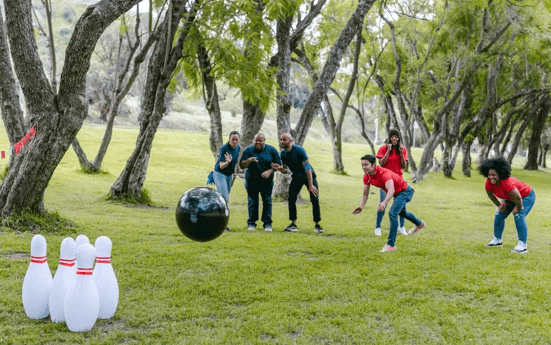If you’ve been hearing more about the concept of ‘Love Languages’ recently, you’re not alone. This popular theory is currently sweeping social media by storm, with the topic boasting nearly 250 million views on Tik Tok alone.
Although commonly used to describe how we prefer to show and receive love in our personal relationships, we wanted to know: how do our love languages play out in our professional relationships at work?

In our recent survey which aimed to uncover the happiest place to work, one in five Brits (21%) confessed that they were dissatisfied with their current job. Pair that with the number of Google searches for queries such as ‘how to quit my job’ increasing by 22% since last year, and employers may find themselves in a bit of a sticky situation when it comes to staff retention.
To find out whether love languages could be the key to building strong colleague relationships – and potentially even bucking the trend during The Great Resignation – we surveyed 2000 UK workers. We wanted to know just how in-sync employers are with their teams, and if they aren’t how they can remedy this by knowing their employees’ love languages.
What Are the Five Love Languages?
In his 1992 book, The Five Love Languages: How to Express Heartfelt Commitment to Your Mate, Gary Chapman outlines five key ways that romantic partners like to show and receive love, known as ‘Love Languages’. According to Chapman’s theory, everyone has one primary and one secondary love language. He believes that we tend to naturally give love in the way we prefer to receive, however by knowing our partner’s love language, we can adjust the way we show love to them and build better a stronger relationship.
The five love languages are:
- Words of affirmation (compliments)
- Quality time
- Receiving gifts
- Acts of service
- Physical touch
In 2011, Chapman co-authored The 5 Languages of Appreciation in the Workplace with Dr Paul White, which applied the love languages to work-based relationships – but does it work in a real-life office setting in 2022? We put the UK’s workforce to the test…
Top love languages for UK workers

53% of our survey respondents could identify their love language. Of those, 33% deemed quality time as their love language. Physical touch was the second most popular love language (28%) followed by words of affirmation (18%).
Acts of service and receiving gifts were the rarest forms of love language, securing 15% and 6% of the vote respectively.

Men were found to be considerably more inclined towards physical touch than women (18% vs just 12%), whereas women were more likely to choose quality time (19%) than men (16%).
Does This Translate to Our Professional Relationships?
Love languages should make your team feel appreciated for their hard work. So, to test whether our love languages align with how we want to be appreciated by the boss, we assigned common ways of showing appreciation to a love language. We then asked UK office workers what makes them feel appreciated at work.
How employees want to be shown appreciation
| Act of appreciation | Attributed love language | % of workers who prefer this |
| Private praise for a good job | Words of affirmation | 51% |
| A pay rise | Receiving gifts | 48% |
| Public praise for a good job | Words of affirmation | 32% |
| Receiving prizes, incentives or bonuses | Receiving gifts | 30% |
| Consistent, prompt feedback | Acts of service | 29% |
| A promotion | Receiving gifts | 26% |
| Getting time to chat with co-workers | Quality time | 25% |
| Being given new opportunities and challenges | Receiving gifts | 25% |
| Someone offering to help you out | Quality time | 22% |
| Being given more control/autonomy over your day | Receiving gifts | 22% |
| Mentorship from someone senior | Acts of service | 17% |
| Workplace team-building activities | Quality time | 16% |
| Someone taking the time to work closely with you | Physical touch | 14% |
| Receiving a handshake or pat on the back | Physical touch | 13% |
Despite words of affirmation only ranking 3rd in the nation’s top love languages, this act of appreciation was unanimously voted as office workers’ preferred way to build professional relationships and feel appreciated at work, with private praise for a good job scoring a whopping 51% of the vote, and public praise securing a solid 32%.
When it comes to receiving gifts, only 6% of us claim this as our love language. However, pay rises (48%), bonuses and promotions (30%) rank extremely highly at work.
Despite physical touch being a firm favourite way to show and receive love outside of work, in the office, this love language might be best avoided – just 14% want to get close and personal when working together, and only 13% would like to receive a handshake for a job well done (sorry, Paul Hollywood).
Whilst quality time ranks number one as the UK’s preferred love language, these acts of appreciation don’t fare quite as well in the office. Getting to spend time with co-workers (25%) and offers of help (22%) are the best ways to show this love language, however, it might be time to reassess your team-building activities (16%) to ensure your staff are getting the most out of them!

A previous study has shown that 17.4% of office workers actually want to ban handshakes altogether following the pandemic, meaning our shared experience of COVID-19 might have pushed physical touch down the rankings in 2022.
Similarly, external factors could be emphasising the importance of bonuses and promotions, as pay is a hot topic at the minute due to the cost of living crisis.
As before, men are more likely to want to receive a handshake or pat on the back at work for a job well done (15%) than women (12%). Women would prefer more autonomy over their working day (25% vs 18% of men) and getting time to chat with co-workers (29% vs 21% of men).
These findings suggest that our personal love language and professional love language could be different.
Are Our Needs Being Met?
Now we’ve established the ways that office workers want to be appreciated, how does that actually match with employers’ methods of appreciation? We asked our survey respondents how they’re most often shown appreciation at work.
| Act of appreciation | Attributed love language | % of workers who've received this act |
| Private praise for a good job | Words of affirmation | 44% |
| Public praise for a good job | Words of affirmation | 23% |
| Consistent, prompt feedback | Acts of service | 19% |
| Getting time to chat with co-workers | Quality time | 17% |
| A pay rise | Receiving gifts | 16% |
| Someone offering to help you out | Acts of service | 14% |
| Receiving prizes, incentives and bonuses | Receiving gifts | 13% |
| Mentorship from someone senior | Acts of service | 12% |
| Being given new opportunities and challenges | Receiving gifts | 12% |
| Receiving a handshake or pat on the back | Physical touch | 11% |
| Workplace team-building activities | Quality time | 10% |
| Being given more control/autonomy over your day | Receiving gifts | 10% |
| Someone taking the time to work closely with you | Physical touch | 8% |
| A promotion | Receiving gifts | 8% |
UK employers are great at using words of affirmation to build strong relationships with their employees, with private praise for a good job (44%) and public praise for a good job (23%) ranking highly on this list. However, the scores also indicate that over half of us (56%) aren’t praised for our efforts at work.
Although receiving gifts was the second most popular way to receive appreciation according to employees, employers aren’t as likely to give them out, with only 12% of us given new opportunities, 10% given more control over their day and just 8% receiving a promotion.
If you’re wanting to improve this love language in your workplace, you don’t need to spend a lot of money to give gifts. Giving your team more flexibility and autonomy over tasks is a great way to give gifts that won’t burn a hole in your back pocket!
Sadly, over 100 respondents (5%) confessed that they had never been shown appreciation at work. This translates to over 1.6 million UK workers.
What About Romantic Office Relationships?
Love languages might not translate when it comes to professional office relationships – but what about your office crush?

Back in February, we quizzed 2000 UK office workers to uncover the most popular tactics they used to gain the attentions of their office crush. Here are the top tactics we found and which love language they relate to.
| Tactic for getting your work crush's attention | Attributed love language | % of workers who prefer this tactic |
| Check in with them regularly | Quality time | 32% |
| Ask for their help with a workplace task | Quality time | 29% |
| Dress to impress | Acts of service | 24% |
| Congratulate them on their achievements | Words of affirmation | 21% |
| Ask them out on a date | Quality time | 21% |
| Use emojis when talking to them online | Words of affirmation | 18% |
| Follow them on social media | Acts of service | 16% |
| Update work profile pictures | Acts of service | 11% |
| Send them a funny GIF | Receiving gifts | 11% |
| Invite them to a lunch break | Quality time | 10% |
Friendly co-worker relationships might not necessarily benefit from the traditional love languages used to build personal relationships, but that’s not the case for office romances.
Our top language (quality time) is a key tactic for getting your work crush’s attention with 92% of us utilising this through checking in with them regularly asking for their help and inviting them out on a lunch break or date.
Although physical touch is the UK’s second most common love language, it doesn’t feature at all in top tactics for getting your work crush’s attention. This could be largely due to touching others being inappropriate in an office setting!
Top Tips from Sean for Building Strong Relationships with Employees
We asked instantprint’s Personal Development and Wellbeing Trainer, Sean Kachmarski, for his top tips on utilising love languages to build stronger relationships with employees for better work satisfaction, retention and output!
1. Get to know your team
Although our findings show that traditional love languages might not always translate into our professional relationships, that doesn’t make them completely redundant. Instead, it’s important to work out what your employees’ professional love language is and make sure you’re providing the right kind of support for them.
2. Assess your current offering
If your current framework for praise or feedback isn’t as effective as it could be, now’s the perfect time to optimise it! Send out an anonymous survey to find out what your employees really want from you to feel appreciated – is it team-building events? More opportunities for growth? Or maybe they’d appreciate a simple thank you from their manager!
3. Say thanks
It’s no coincidence that words of affirmation is the top love language in the workplace and the top way employees feel appreciated is by being told they’ve done a good job. Make sure to give genuine praise when it’s warranted to show employees just how much you value the hard work they’ve put in.
In Conclusion
Although the theory of love language might not always translate to office relationships, words of affirmation go a long way to building relationships, whether personal or professional. Get to know your team’s office love language and make sure you’re showing appreciation for their hard work – it could be the reinforcement you need to ensure you’re keeping the best staff engaged and employed with your business.

 (1).png)



.jpg)